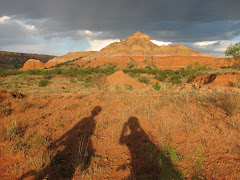
production, as well as the modern process, from farming

through finished products. They have women from rural areas where alpaca are raised, showing how the fiber is separated, processed, and woven into products. It's a really nice place, and an educational experience. Of course they
have a gift shop, where you can buy some of the nicest (and most expensive) alpaca products that we
see for the entire trip.
We walk across town, over the Chili River, to the town of Yanahuara where we encounter several small protests related to the struggles that are going on in the northern Amazon. These are just a few small, peaceful marches, but there are police in riot gear located at several points in Yanahuara as well as Arequipa.

With the encouragement of a few local women, we hike up to the Mirador Yanahuara, another beautiful plaza with requisite cathedral, and an excellent viewpoint overlooking Arequipa. We were running a little behind, time-wise, but these women were insistent that we check out the beautiful view. We have lunch at a very nice restaurant there. I have Lomo Saltado - alpaca meat stir-fried with some veggies. It is great. Very lean, but not gamey, sort of like bison. We race back to our hotel in a cab to prepare for our raft trip.
We are picked up by the rafting company in a van. After picking up more tourists

around the touristy section of the city, we head out of town. They stop at their out-of-town HQ to hitch up a trailer with rafts, and we're off again. The scenery of the country is interesting, lots of agriculture. Finally we are at the put-in. They suit us up in wetsuits, helmets, life vests, and old keds sneakers, and divide us into 3 boats, each with a guide. After a brief instructional session we are off. This section of the Chili River has a ton of class II, a few sections of III, and one section of IV. It is aptly named, as the water is FREEZING. We are mostly warm in our wetsuits, but our feet are cold. We share our boat with an Italian couple. It is a total blast, with almost continuous, super-fun whitewater for over an hour. There are 2 places where we have to walk a short distance, one of them in the water. It is frigid. When we were at the office, and they said we'd only be on the river for just over an hour, I'd almost voted not to take the trip, but it turns out to be well worth it. Really, really fun!

A couple of Allison's colleagues, Priscilla and Ernie, lead student trips to Peru periodically, and among their many recommendations for the trip is a rooftop restaurant on the Plaza de Armas.

It is supposed to have an excellent sunset view, so we race to change clothes and head down to the Plaza. On the way, we pass by the rafting company, right when one of our guides is coming out. He recognizes us, and is excited -- he goes
back into the office to grab mom's flip-flops, which she left in the van. We get to the restaurant just after sunset, but the sky is still pretty. I try what has become the national drink of Peru, the Pisco Sour. Pisco is a liquor distilled from grapes. It was developed by Spanish settlers in the sixteenth century. Chile and Peru tend to fight over ownership of Pisco. Chile produces and exports more, but it has been a part of Peru's history for much longer. In a trip report that Gerry Weber wrote of he and Anneke's trip to Peru a few years ago, he said "Piscos Abound!" We now know what he meant, the drink is everywhere. The recipe is loosely thus:

2 oz. Pisco
1 oz. Lime Juice
3/4 oz Simple Syrup
1 Egg White
1 Dash Bitters
Shake hard or blend with ice and strain into a glass. The bitters are an aromatic garnish to top the foam.
It is excellent, although it violates one of a number of don't-get-sick precautions: it contains ice, which undoubtedly was produced with TAP WATER, which most likely contains WEE BEASTIES (as Leeuwenhoek would've said). We are of course not supposed to drink tap water, not supposed to eat fruits or vegetables washed in water (unless we are peeling them OURSELVES), not supposed to drink fountain drinks or drinks with ice, not supposed to eat food from street vendors, and not supposed to rinse toothbrushes with tap water, among other things. These precautions become routine, and are not that much of a hassle, although it is a bit of a shame not to be able to eat street food. Below in the square there is traditional music, dance, and costumes. It is the Fiesta de Corpus Christi. We soon realize that Peru is Fiesta central -- almost everywhere we go there is some sort of celebration (or two).






